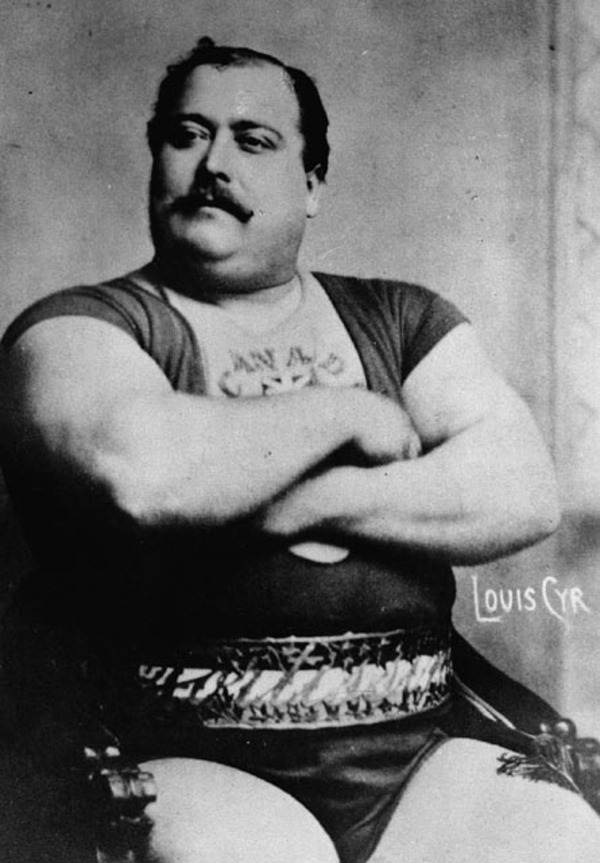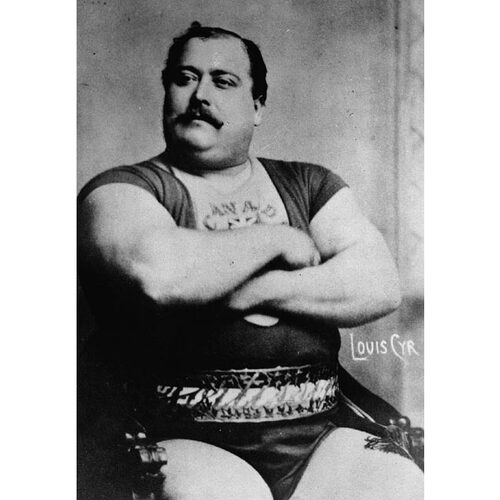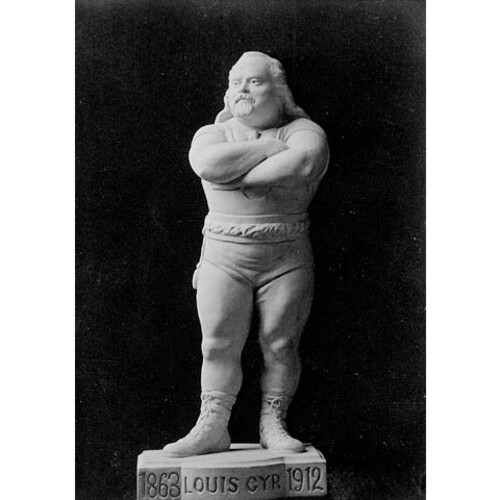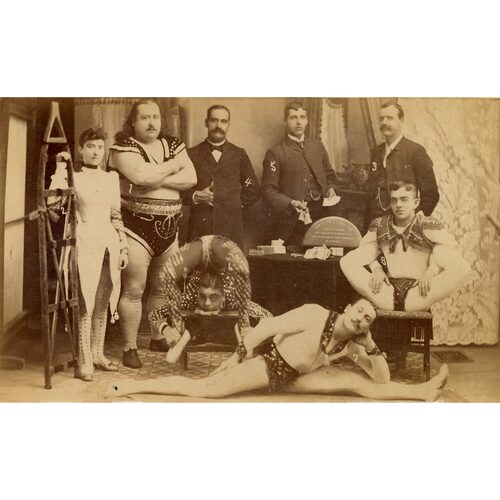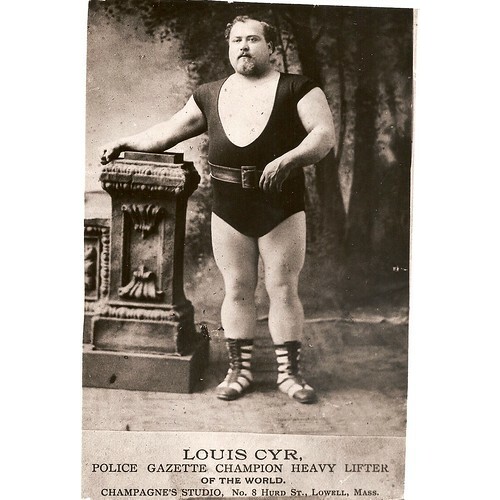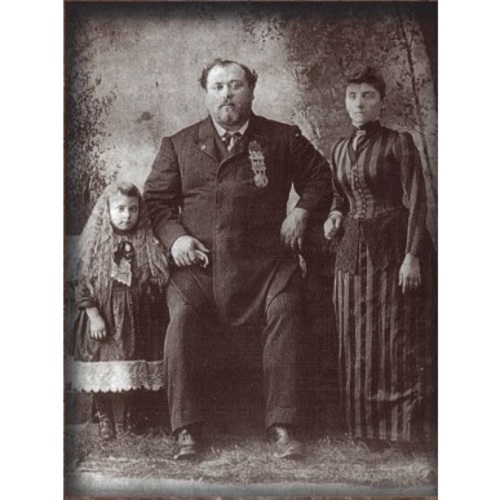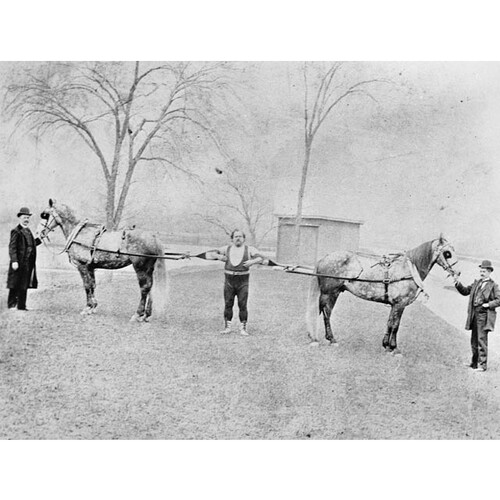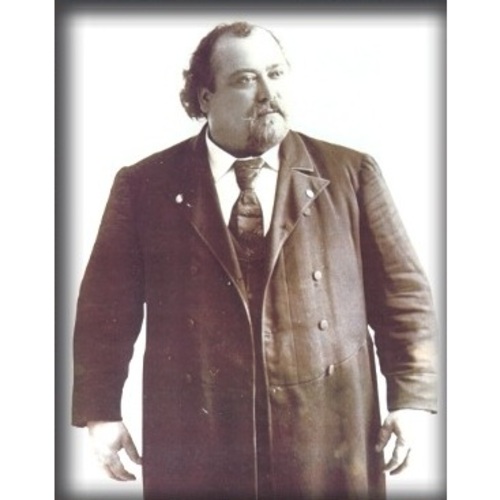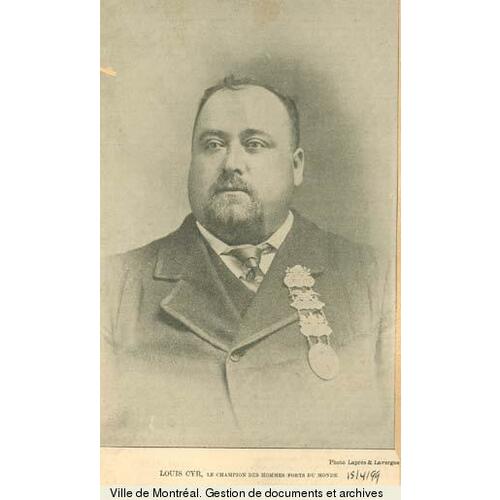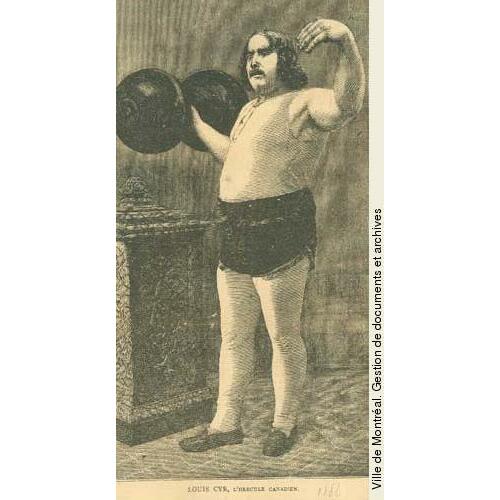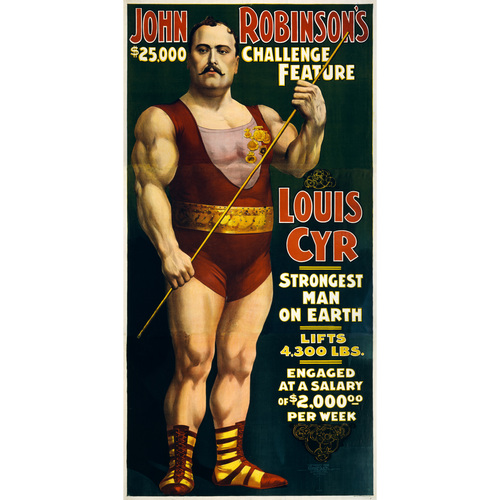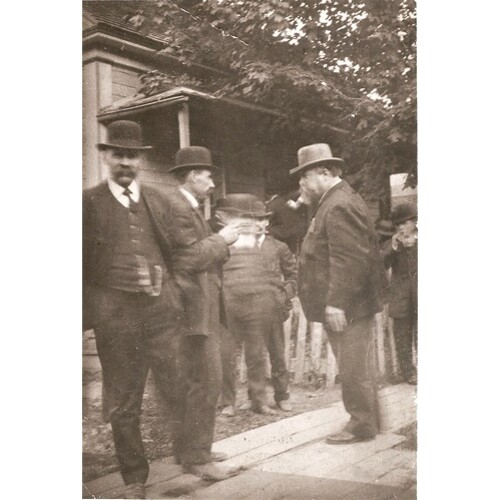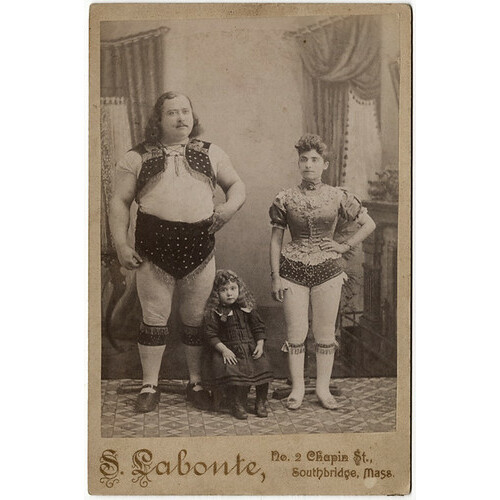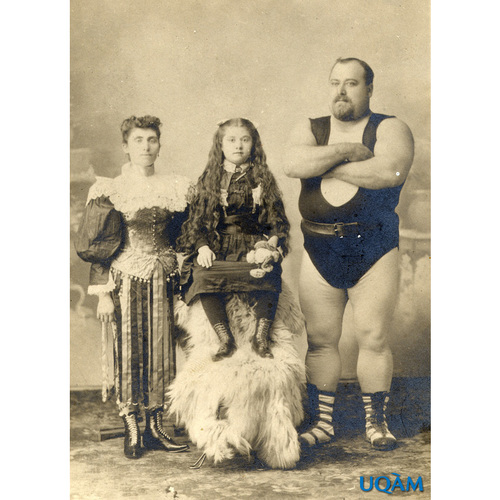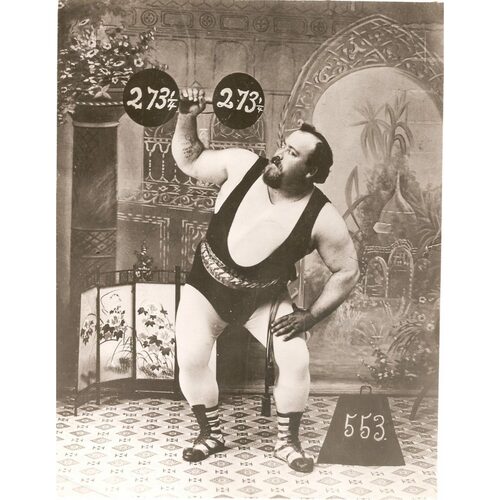As part of the funding agreement between the Dictionary of Canadian Biography and the Canadian Museum of History, we invite readers to take part in a short survey.
CYR, LOUIS (baptized Cyprien-Noë; he used Cyprien-Noé until about 1879), labourer, weightlifter, performance athlete, policeman, firefighter, and co-owner of circuses; b. 10 Oct. 1863 in Saint-Cyprien (Saint-Cyprien-de-Napierville), Lower Canada, son of Pierre Cyr, a farmer, and Philomène Berger; m. 16 Jan. 1882 Mélina Comtois in Saint-Jean-de-Matha, Que., and they had a daughter and a son; d. 10 Nov. 1912 in Montreal.
Background and early years
The eldest son and second in a family that would number 15 children, Louis Cyr (then known as Cyprien-Noé) spent his childhood and adolescence in Saint-Cyprien, within the boundaries of a few acres of land. He was hampered by illiteracy, having attended the boys’ school in the neighbouring village of Napierville for no more than 12 months between 1872 and 1875. Although he was sturdy and heavy-set in his childhood, he exhibited no signs of prodigious strength. The stories told by his great-grandfather Pierre and his grandfather Pierre Cyr about the physical exploits of famous strongmen, such as Jos Montferrand [Joseph Montferrand*, known as Favre] and Claude Grenache, influenced him in his early years.
First feats of strength
Fascinated by the efforts exerted by draft horses, at the age of 14 Cyr attempted his first test of strength. He would name it, as La Presse reported on 7 March 1908, the “feat of the horse”: with his feet braced against the barn’s threshold, he resisted the pull of a horse by holding its harness with both hands. He would repeat such acts with more powerful horses, accomplishments that became inextricably linked with his career as a strongman, which lasted from 1883 to 1906.
In the autumn of 1878 Cyr gave two displays of his physical prowess. Beside the mill at Saint-Athanase (Saint-Jean-sur-Richelieu) he carried on his back, over a distance of 15 feet, a stable door piled with 15 bushels of grain. As he would relate in the 14 March 1908 issue of La Presse, this was one of the most significant events of his adolescence and one in which he took great pride. That autumn he lifted, by its hitching shaft, a cart mounted on an iron chassis; its weight exceeded 1,000 pounds.
Years in Lowell
In November 1878 Cyr, his parents – Pierre Cyr and Philomène Berger – and his ten brothers and sisters set off for Lowell, Mass. They joined nearly 200,000 French Canadians who, having fled subsistence farming in pursuit of the impossible dream of a better life, were dispersed throughout the New England states. A centre of the textile industry, Lowell was at that time a community of some 60,000 people, about 40 per cent of whom were from other countries. Among them were 10,000 French Canadians living in a crowded ghetto nicknamed Little Canada, next to that of the Irish. In this insalubrious milieu, with its inhumane working conditions, the Cyr family was forced into debt and exposed to the brutal labour regime in the spinning mills.
It was in this hostile environment that Louis Cyr emerged as an exceptional man who would go on to make his mark performing in Canada, the United States, and England. Because Americans mispronounced his given names, he started to call himself Louis while employed at the Suffolk Manufacturing Company. There, at barely 17, he did the work of two men, single-handedly piling up crates of cotton weighing several hundred pounds. The result was that people talked of little else but his exploits.
Cyr met Mélina Comtois in Lowell. He left the town in December 1881 to travel to the Comtois residence in Saint-Jean-de-Matha, and on 16 January of the following year, he married the woman with whom he would share the rest of his life. Of their two children, only Emiliana, born on 30 Jan. 1887 in Sainte-Cunégonde (Montreal), reached adulthood.
In the spring of 1883 the couple returned to Lowell. During their time there Cyr realized that his physical strength would change his life dramatically. When he was not yet 20 years old, one Sunday just outside the town he raised a field stone from the ground to his shoulders while more than 4,000 people watched. According to the scales at Olivier Gaudette’s general store, the stone weighed 517 pounds – an achievement that contributed to establishing Cyr’s strongman reputation.
Tours and shows of strength
An unscrupulous horse dealer by the name of Mac Sohmer persuaded Cyr to earn money using his gift of strength. Promising a weekly salary of $25, Sohmer organized a tour of the Maritime provinces for him. Cyr and his wife left Lowell for Moncton, N.B., at the beginning of June. The venture lasted two months and drew large crowds. However, it turned out to be a financial disaster for Cyr, who in the end received the equivalent of only two weeks’ salary from Sohmer. It was a life lesson that would serve Cyr for the rest of his career.
Back in his native province Cyr arranged his own tour over the course of the summer. In October and November he travelled throughout the Montérégie region. The following spring he went to Montreal, where he met Gustave-Esdras (Gus) Lambert, the owner of Lambert House and a promoter of sporting events. Lambert taught him the art of strongman entertainment. Thanks to him, Cyr gave his first show in the city at Mechanics Hall, where he lifted 450 pounds with one finger and used his back to raise a platform holding 15 men off its sawhorse support. On 1 Oct. 1888 he successfully repeated the challenge with a 3,536-pound load at the Collège Saint-Joseph de Berthier (Berthierville), and on 27 May 1895 with 4,300 pounds at the auditorium of the Austin and Stone’s Museum in Boston. According to the New York Clipper of 8 June, he had established “a new record for this style of lifting.”
Policeman and firefighter
In 1884 the mayor of Sainte-Cunégonde, Hubert Morin, offered Cyr a job with the city’s police force and fire brigade, giving him a clear mandate to use any means necessary to ensure safety in every district. Cyr’s colossal presence made itself felt, and his growing reputation gave rise to numerous urban legends. He was already acknowledged as the Canadian Samson. Having reached the conclusion that this life was not for him (he was afraid he would die on the job), Cyr officially turned in his uniform on 20 Dec. 1885.
The strongest man
On 16 March 1886 at Quebec City’s Salle Jacques-Cartier, Cyr claimed a decisive victory over city champion David Michaud and began to win recognition as the strongest man in Canada. On 2 Nov. 1889 at the Saint-Henri (Montreal) town hall, Cyr defeated Horace Barré, considered a major Canadian rival, and managed a one-arm press of a 265-pound barbell.
On 5 Dec. 1890, having accepted an invitation from Richard Kyle Fox, promoter and owner of the National Police Gazette, Cyr became an instant star by performing a series of lifts before observers and journalists gathered in the weekly’s offices in New York City. Almost a year later the demonstration led to the opportunity to go to England to compete for the title of the world’s strongest man.
Meanwhile, on 26 Jan. 1891, the Association Saint-Jean-Baptiste de Montréal and other francophone societies awarded Cyr a belt inscribed with the word “Fortissimo,” in honour of his contribution to promoting French Canada. The following autumn, in Montreal’s Sohmer Park, he performed a remarkable tour de force that cemented his already legendary reputation: every evening from 20 to 26 September, he restrained, for nearly a minute, four horses (two per arm) belonging to the King’s City Express, a combined weight of 4,800 pounds. Each appearance earned him $100.
From 10 Nov. 1891 to 9 March 1892, Cyr toured the heart of the British empire. Appearing on the major stages of Liverpool, Birmingham, Manchester, and London, he held off the greatest champions of Prussia, Italy, Austria, and England. He never competed against the most famous of the group, Friedrich Wilhelm Müller (known as Eugen Sandow), having failed to agree on conditions for a contest. As he explained in an article published in La Presse (24 Oct. 1908), “strong men in different categories who vied for the audience’s favour … issued challenges to each other, without ever meeting.”
On the evening of 19 February, before 5,000 spectators at the Royal Aquarium in Westminster (London), Cyr established four records, the most impressive of which was a one-arm clean lift, followed by a press of a 273¼-pound weight, a record that would stand for 122 years. To the representative of London’s Sporting Life, which published his remarks the next day, Cyr declared: “I will nonetheless beat many records, and when I leave England I will add numbers to the record books that will take many years to wipe out. I have come to the conclusion that no one will make a match with me, so I might just as well wipe out all other people’s records, and have an unbroken list all to myself.” Increasingly, Cyr asserted that he was the world’s strongest man. On 19 September he was back in Montreal; the city awarded him a medal of honour made of gold, which in addition to the symbols of Canada, the United States, and England, bore the inscription “the strongest man in the world.”
In his spare time, between 1889 and 1901, Cyr also competed against a few renowned adversaries, such as Barré, Frank Bienkowski (known as Cyclops), Sébastien Miller, August W. Johnson, Otto Ronaldo, and Herman Smith. These encounters added nothing to Cyr’s well-established fame, except to solidify his reputation as a man who backed down from no one.
Tours with the big top
His status established in England, Cyr now set out to conquer the United States. In 1892 he founded the Cyr Brothers with his brother Pierre and increased the number of his tours until 1896. Audiences in seven American states (the majority in New England) witnessed Louis’s exploits, and most of the New York, Chicago, and Boston newspapers published accounts, sometimes exaggerated, of his strength. The high point for the world’s strongest man came on 8 May 1896 in Chicago’s St Louis Hall while on tour with his family. Cyr established seven records, lifting a total of 10,671¼ pounds in nine events. He also restrained four 1,200-pound horses, two strapped to each of his bent elbows and pulling in opposite directions.
In 1897 Cyr was drawn to a major 19th-century North American phenomenon: the big top. He became the star of John Robinson’s Circus, which paid him up to $2,000 a week, and the following year, he was the main attraction of the Ringling Brothers. He travelled with their circus through numerous American states and made his fortune. At the close of 1898 he put an end to what was, for him, too long an absence from home and “hell,” as he would describe it in La Presse on 1 Aug. 1908.
Cyr nevertheless took advantage of this unique experience to organize his own circus in 1899, a venture that would last until 1905. Initially in association with Barré, and then Ronaldo from 1901, and subsequently the hotelier Louis Vallée in 1904, Cyr stopped in many communities in the province of Quebec, attracting hundreds of thousands of spectators and enjoying financial success. According to comments by historian Jacques Clairoux in L’Annuaire théâtral, Cyr “had managed to adapt athletic ability to the stage.”
Last years of his career
In the summer of 1901 Cyr began to experience much physical discomfort: swelling, back pain, fever, and digestive problems. He was diagnosed with Bright’s disease by Sir William Hales Hingston*, a physician and former mayor of Montreal. Submitting to a drastic regimen, Cyr would gradually eliminate solid food from his diet. By his early forties, he knew that his career as a strongman was compromised and his life expectancy seriously reduced. On 26 Jan. 1904 La Presse published a certificate from his doctor that justified his inability to accept a challenge from a young prodigy, Hector Décarie, 17 years his junior. Nevertheless, on 26 Feb. 1906 Cyr confronted him at Sohmer Park. Although the match ended in a tie, the newspapers cast doubt on Cyr’s reputed invincibility. The next day La Presse deplored the fact that Cyr and Décarie had “lifted very ordinary weights” and pointed out, in particular, that “each competitor performed HIS feat of strength alternately, and won HIS point, then acknowledged the feat of the other.” When the event was finished, Cyr surrendered his title of “champion of strong men of the universe” to Décarie, as La Patrie reported (27 February), and announced his retirement. It was the end of a great era and the unbroken reign of a man of dominant strength.
Memoirs and assessment
In January 1908 Arthur Berthiaume, deputy editor of La Presse, undertook to publish the memoirs of the former strongman. For 39 weeks, on Saturdays between February and November, articles signed by the journalist Louis-Septime Laferrière appeared in the daily, thus documenting Cyr’s life for posterity.
Louis Cyr died on 10 Nov. 1912 at the Montreal residence of his son-in-law, Dr Zénon-Maxime Aumont. His funeral was held on 14 November in the Saint-Pierre-Apôtre church, and he was buried the following year in the cemetery of Saint-Jean-de-Matha, his adopted home. The funeral vault, surmounted by a stone cross, bears the words “Here lies Louis Cyr champion of the strong men.”
In his 23-year public career as a strength athlete, Louis Cyr travelled through Canada, the United States, and England and gave almost 2,500 performances. He restrained pairs of horses over 500 times. Between 1885 and 1900 he held numerous records. In recognition of his exceptional strength, the Historic Sites and Monuments Board of Canada named him a person of national historic significance in 1976. He was inducted into Canada’s Sports Hall of Fame in 1955 and the Panthéon des Sports du Québec in 2001. In 2013, on the 150th anniversary of his birth, Quebec’s Ministry of Culture and Communications designated him a historic figure.
Over a ten-year period the author has gathered a body of administrative, notarial, and legal documents, correspondence, and historical works on the migration of French Canadians to New England, competitions of strength in North America and Europe, and French Canadian genealogy. Accounts of contests of strength by contemporary historians, as well as those by 15 international champions from as many countries, were also compiled. A collection of 351 articles – published between 1885 and 1912 in 74 newspapers in Quebec, Ontario, New Brunswick, Manitoba, 22 North American states, Great Britain, Germany, and France – has been created. This biography is based on an exhaustive list of works, which can be found in the author’s book Louis Cyr, une épopée légendaire (Outremont (Montréal), 2005). A revised and enhanced edition appeared under the title Louis Cyr: biographie (Montréal, 2013) on the occasion of that year’s release of the film Louis Cyr, the strongest man in the world (directed by Daniel Roby, screenplay by Sylvain Guy).
Ancestry.com, “Quebec, Canada, vital and church records (Drouin coll.), 1621–1968,” Basilique Notre-Dame (Montréal), Noé Cyprien Louis Cyr, 14 nov. 1912: www.ancestry.ca/search/collections/1091 (consulted 16 Sept. 2022). Bibliothèque et Arch. Nationales du Québec, Centre d’arch. de Montréal, CE604-S6, 11 oct. 1863; CE605-S30, 16 janv. 1882. Jacques Clairoux, “Du spectacle de la force à l’athlétisme théâtral: Louis Cyr et le cirque au Québec,” L’Annuaire théâtral (Montréal), printemps 1988: 107–24. Edmond Desbonnet, Les rois de la force: histoire de tous les hommes forts depuis les temps anciens jusqu’à nos jours (Paris, 1911). Martin Franklin, Louis Cyr, l’homme le plus fort du monde ([Montréal, 1946]). G. F. Jowett, The strongest man that ever lived (Philadelphia, [1927]). A.-N. Montpetit, Nos hommes forts … (Québec, 1884). Yves Roby, The Franco-Americans of New England: dreams and realities, trans. M. E. Brennan-Ricard (Sillery [Quebec], 2004). Jack Tremblay, Louis Cyr: the story of the strongest man who ever lived (Fredericton, [1967]). La Vigilante (Saint-Jean-sur-Richelieu, Québec), 35 (2014), no.1, numéro spécial intitulé Louis Cyr à l’apogée de sa gloire. Ben Weider, The strongest man in history: Louis Cyr, “amazing Canadian” (Vancouver and Toronto, 1976). Ben Weider et É.-Z. Massicotte, Les hommes forts du Québec: de Jos. Montferrand à Louis Cyr (Trois-Pistoles, Québec, 1999). D. P. Willoughby, The super-athletes (South Brunswick, N.J., [1970]).
Cite This Article
Paul Ohl, “CYR, LOUIS (baptized Cyprien-Noë) (Cyprien-Noé),” in Dictionary of Canadian Biography, vol. 14, University of Toronto/Université Laval, 2003–, accessed March 31, 2025, https://www.biographi.ca/en/bio/cyr_louis_14E.html.
The citation above shows the format for footnotes and endnotes according to the Chicago manual of style (16th edition). Information to be used in other citation formats:
| Permalink: | https://www.biographi.ca/en/bio/cyr_louis_14E.html |
| Author of Article: | Paul Ohl |
| Title of Article: | CYR, LOUIS (baptized Cyprien-Noë) (Cyprien-Noé) |
| Publication Name: | Dictionary of Canadian Biography, vol. 14 |
| Publisher: | University of Toronto/Université Laval |
| Year of publication: | 1998 |
| Year of revision: | 2023 |
| Access Date: | March 31, 2025 |


